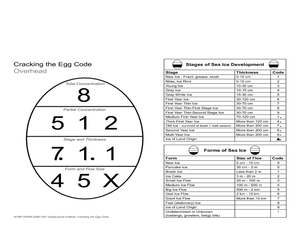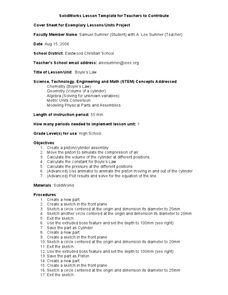Curated OER
Capacity
Eighth graders explore the term capacity and understand the word's meaning. They participate in several lab stations set up around the room in which they will estimate how many scoops it will take to fill the container. They then will...
Curated OER
How Can You Measure This?
Third graders work in small groups to complete a number of investigations in which they have to use measurement. They determine the fractional part of the newspaper that is used for news, sports, etc. They compare their height to their...
Curated OER
Making The Height
Twelfth graders apply estimation techniques to determine how high any one basketball player can jump.
Curated OER
Models and Algorithms to Solve Multiplication Problems
Students choose the correct strategy to solve multiplication and division. In this algorithm lesson, students use at least two strategies that use properties of operations and estimation. Students also recognize the relationship between...
Curated OER
Strength in Size? Madagascar Cockroach Pulls
Fourth graders conduct an experiment involving size and relative ability in smaller species using Madagascar cockroaches. They make predictions about how many pennies the roaches can pull, compare the results to human strength, and...
Curated OER
A Tour of the Solar System
Students construct a spacecraft out of Lego blocks and other materials. They work on their models in small groups while building. They become familar with the planets while working cooperatively.
Curated OER
Sea Ice: Cracking the Egg Code
Students study the egg code to learn about sea ice. In this sea ice instructional activity, students discuss and view a diagram to learn about the egg code when describing sea ice and its thickness. Students work in groups to play a game...
Curated OER
Boyle's Law
Students create a piston/cylinder assembly using SolidWorks. In this technology lesson, students calculate volume, pressure and Boyle's law constant. They simulate equalizing air pressure by moving the piston out of the cylinder.
Curated OER
Time Zones
Students are able to read and also use a variety of timetables and charts. They perform calculations with time, including 24-hour clock times and time zones. These are very important concepts that Students probably have to bear in mind...
Curated OER
Playing with Money (From the New Zealand Point of View)
Students explore the exchange rates for five countries. They identify the units of currency of a number of countries. Students convert money amounts accurately from New Zealand dollars to another currency. They graph currency...
Curated OER
Playing with Money (From the Other Point of View)
Students explore exchange rates. They identify the units of currency of a number of countries. Students convert money amounts accurately. They graph currency fluctuations and interpret graphs.
Curated OER
Similar Triangles - Applied Problems
Students differentiate between similar and congruent triangles. In this geometry instructional activity, students identify the angles of triangles using the similarity theorem. They apply concepts of triangles to the real world.
Curated OER
How big is a whale
Students research the size of whales using print books or the internet. Students do the research in groups. They compare and graph the results.
Curated OER
Create a Full-Scale Layout of the International Space Station
Students work together to convert scale dimensions to determine the true size of the International Space Station. They create a full-scale outline of the station. They share their layout with the class.
Curated OER
Measurement, Perimeter and Area
Learners explore the concept of measurement. In this measurement instructional activity, students collect data about themselves such as height, finger length, neck circumference, foot length, and other body measurements. Learners cut...
Curated OER
Penguin Heights
Young scholars use the worksheet from the first website listed below to collect data on the penguin heights on the Penguin Page.
Curated OER
Make a Zoo
In this unit students work in groups to find out about an endangered animal species. They design a zoo enclosure for the animal and build a scale model. Together the class constructs a zoo! In the process of planning and building the zoo...
Exploratorium
Tired Weight
Take your class out to visit your automobile and use the tires to compute the weight of the vehicle. This is done by measuring the surface of the tire meeting the ground and the air pressure. This is a fun lesson in the relationship...
Exploratorium
Tired Weight
You don't need a scale to determine weight. This activity provides a way to use the concepts of air pressure and surface area to determine the weight of a vehicle by calculating the amount of weight each tire supports.
Curated OER
How Large is a Mole of M&M's
Students calculate whether or not a mole of M&M's fill their high school. They practice factor-labeling, define a mole, and calculate the number of cubic feet per mole of M&M's. To answer the question they measure and calculate...
Alabama Learning Exchange
Effects of Friction on a Moving Block
Learners investigate how friction affects the movement of a block across surface areas. They test five different kinds of surfaces—smooth surface, wax paper, a paper towel, course, and fine sandpaper. They predict and record the results...
Curated OER
Reading distance on maps
Eighth graders complete worksheets on reading the distance on maps in miles or kilometers. In this maps lesson plan, 8th graders use a calculator and ruler.
Curated OER
Reading Trees: Understanding Dendrochronology
Students examine tree-ring dating and discuss the lack of water the settlers in Jamestown faced. They create paper tree rings, simulate rain patterns, and describe the history of construction paper tree sequences.
Curated OER
Tomb Explorer/Temple Explorer
Fourth graders build an explorer vehicle which they program through an obstacle course to enter the tomb or temple to discover artifacts.

























